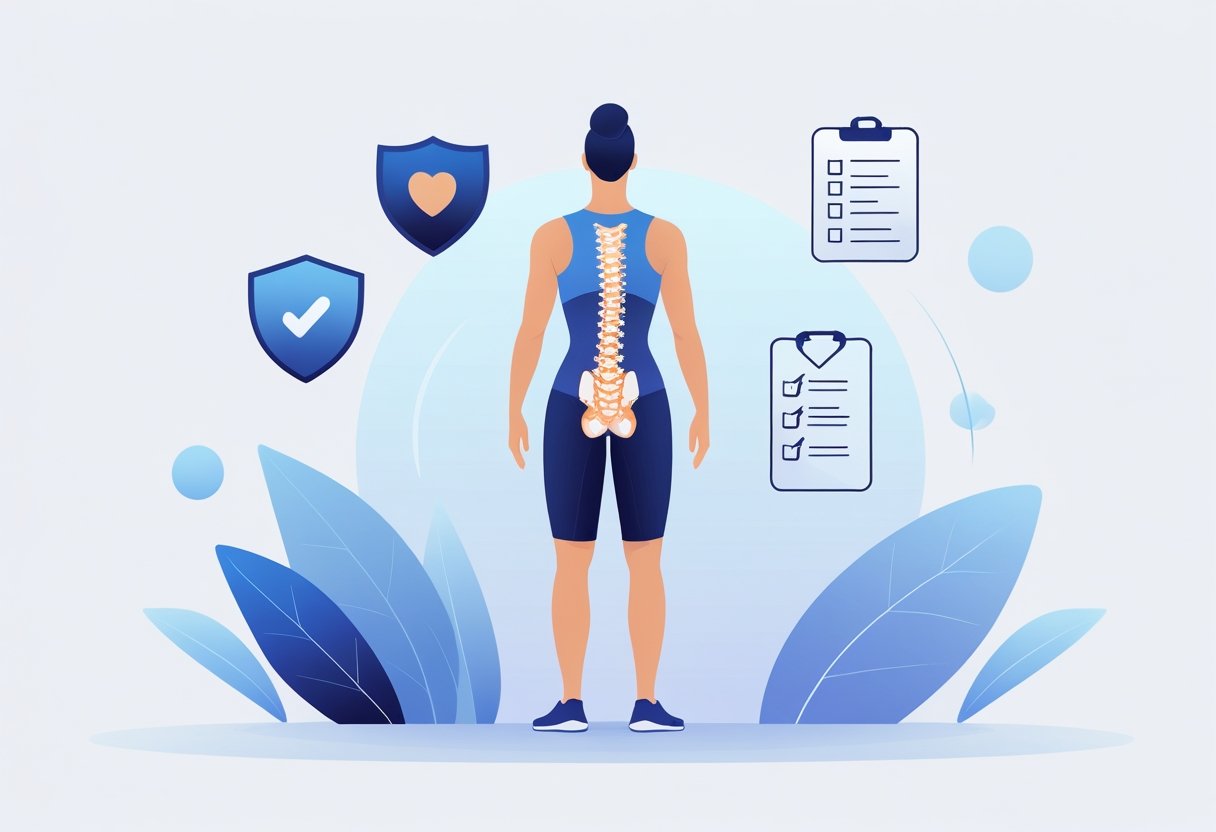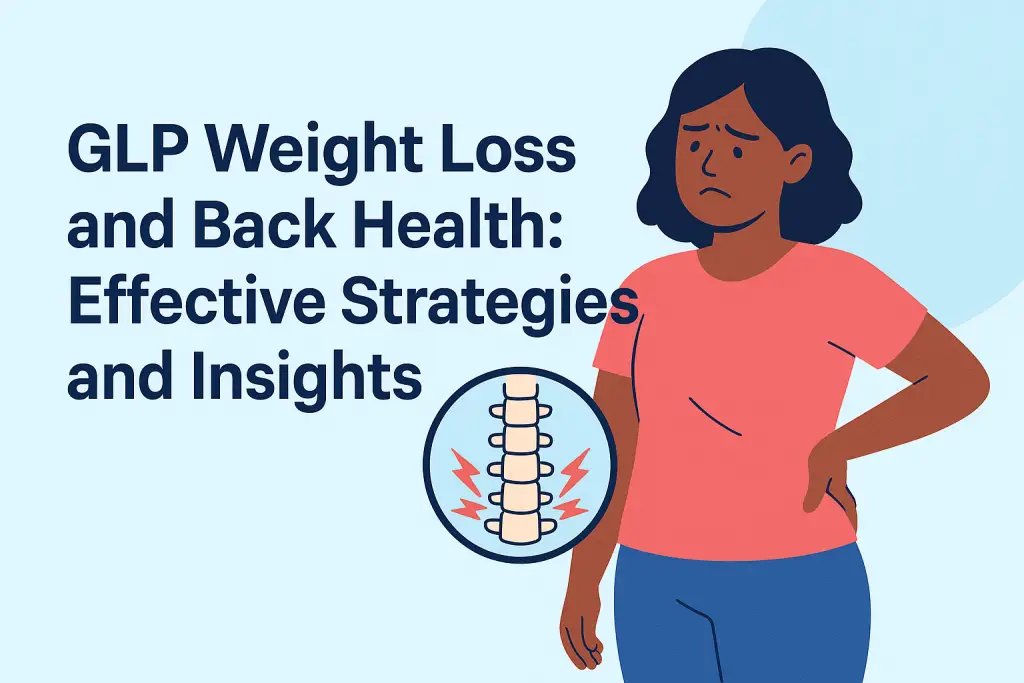GLP-1 medications, originally developed to manage diabetes, have gained attention for their ability to promote significant weight loss. This weight loss can directly impact back health by reducing the mechanical strain on the spine and lowering inflammation associated with excess fat. For individuals struggling with obesity-related back pain, GLP-1 assisted weight loss offers a practical way to relieve pressure on the spine and improve mobility.

Excess weight increases stress on the lower back, worsening pain and limiting physical activity, which in turn can lead to further weight gain. By supporting sustained weight loss, GLP-1 drugs help break this cycle, potentially reducing back pain over time.
While GLP-1 medications are not a direct treatment for back pain, their role in weight management makes them an important tool in addressing one of the root causes of spinal discomfort. Combining these drugs with lifestyle changes can enhance overall spine health and quality of life. For more detailed information, visit this article on back pain and GLP-1 assisted weight loss.
Understanding GLP-1 Weight Loss Therapies
GLP-1 weight loss therapies work by targeting hormonal pathways that regulate appetite, blood sugar, and digestion. These treatments offer measurable benefits for individuals with obesity, overweight, or type 2 diabetes, often leading to significant weight reduction and improved metabolic health.
Mechanism of Action
GLP-1 receptor agonists mimic the naturally occurring glucagon-like peptide-1 hormone. This hormone influences multiple metabolic processes, including increased insulin secretion and decreased glucagon release. It also slows gastric emptying, which contributes to a feeling of fullness.
Another critical effect is appetite suppression via the hypothalamus, reducing calorie intake. This combination of actions leads to sustained weight loss and better blood glucose control. Unlike some weight loss methods, GLP-1 agonists address both central and peripheral pathways involved in metabolism.
These mechanisms make GLP-1 receptor agonists effective for people with obesity or type 2 diabetes by improving metabolic function while reducing excess body weight.
Key Medications: semaglutide, Ozempic, Wegovy, Tirzepatide
Several GLP-1 receptor agonists have gained approval for weight management and diabetes. Semaglutide is a prominent example, marketed under brand names such as Ozempic and Wegovy. Ozempic primarily treats type 2 diabetes, while Wegovy focuses on chronic weight management.
Tirzepatide is a newer dual agonist that targets both GLP-1 and glucose-dependent insulinotropic polypeptide (GIP) receptors. This dual action enhances metabolic benefits beyond those seen with GLP-1 alone. Clinical use of tirzepatide has demonstrated significant reductions in body weight and improved glycemic control.
Dosage and administration vary by medication, with most given as weekly injections. These medications are intended to complement lifestyle changes like diet and exercise, not replace them.
| Medication | Primary Use | Mode of Action | Administration |
|---|---|---|---|
| Semaglutide | Diabetes & Weight Loss | GLP-1 receptor agonist | Weekly injection |
| Ozempic | Type 2 Diabetes | GLP-1 receptor agonist | Weekly injection |
| Wegovy | Weight Management | GLP-1 receptor agonist | Weekly injection |
| Tirzepatide | Diabetes & Obesity | GLP-1 & GIP dual agonist | Weekly injection |
Clinical Trials and Effectiveness
Clinical trials have consistently shown that GLP-1 receptor agonists produce meaningful weight loss. Studies like the STEP program found semaglutide led to average body weight reductions between 15-20% over 68 weeks in individuals with obesity or overweight.
Tirzepatide trials have reported even greater weight loss, often surpassing 20% when paired with lifestyle interventions. These results are significant compared to earlier weight management treatments and rival outcomes from bariatric surgery.
GLP-1 therapies also improve secondary outcomes such as blood sugar control, blood pressure, and lipid levels. Side effects, most commonly gastrointestinal issues like nausea, are generally transient and manageable.
Continued research supports the use of GLP-1 receptor agonists as effective tools in obesity and diabetes treatment, especially when combined with supportive care. For additional details on clinical trial data, see the information on semaglutide and GLP-1 receptor agonists.
Impact of GLP-1 Therapies on Back Health

GLP-1 therapies help reduce body weight, which can lessen stress on the spine and associated structures. This weight loss may affect pain levels and improve mobility for individuals struggling with obesity-related back issues.
Weight Loss and Spinal Load Reduction
Excess body weight increases mechanical load on the spine, accelerating wear on vertebrae and intervertebral discs. GLP-1 receptor agonists such as semaglutide promote significant weight loss, often exceeding 15% of body weight within a year. This reduction lowers spinal load, which can decrease the risk of structural damage and degeneration.
Less load on the spine improves overall posture and movement, reducing the likelihood of back strain. The association between obesity and back pain is well documented, so weight loss through GLP-1 therapies presents a clear route to reduce these mechanical stressors.
Potential for Pain Relief in Osteoarthritis and the Spine
GLP-1-induced weight loss can alleviate pain linked to osteoarthritis in the spine and other joints. By reducing body weight, there is less pressure on cartilage and bone, which may slow disease progression. Improved metabolic health after GLP-1 treatment could also support tissue repair and reduce inflammation.
However, some studies show GLP-1 weight loss is accompanied by reductions in lean mass, including muscle. Maintaining muscle strength through diet and exercise is crucial to support spinal stability and prevent further pain or injury during therapy.
For more details on GLP-1 benefits related to back pain, see this Back Pain and GLP-1 Assisted Weight Loss article.
Side Effects and Safety Considerations

GLP-1 weight loss medications can impact various aspects of health, including digestive function and muscle integrity, making their safety profile important to review. While many side effects are manageable, some require attention to maintain overall well-being. Long-term data from clinical trials provide insight into their sustained effects and risks.
Common Gastrointestinal Issues
Gastrointestinal side effects are the most frequently reported with GLP-1 medications. Nausea, vomiting, diarrhea, and constipation occur especially during the initial weeks of treatment. These symptoms typically improve as the body adjusts.
Patients may experience reduced appetite and slowed gastric emptying, which contribute to weight loss but can also cause discomfort. Dose adjustments and timing of medication can help reduce these issues.
Persistent or severe gastrointestinal symptoms may require medical evaluation to rule out other causes. Monitoring helps maintain safe use, as these effects can impact hydration and nutrient absorption.
Muscle Mass and Functional Implications
Rapid weight loss with GLP-1 drugs can sometimes lead to muscle mass reduction, which is a concern for back health and overall physical function. Loss of muscle strength may increase the risk of injury or chronic pain.
It is important for individuals on these medications to incorporate resistance training and adequate protein intake to preserve muscle. Healthcare providers often recommend physical activity tailored to maintain muscle function.
Clinical trials have not shown significant long-term muscle damage, but monitoring muscle mass is critical for those with preexisting musculoskeletal conditions or elderly patients.
One of our favorite ways to monitor strength, diet, and resistance exercise while using a GLP-1 weight loss is through GLPStrengthRX. This is a web based app that helps track diet, creates custom workouts based on your experience level, has AI meal planning, and coaching along the journey.
Long-Term Safety Insights
Long-term clinical trials indicate GLP-1 receptor agonists are generally safe when used as prescribed. They consistently show benefits in weight loss and metabolic control with manageable side effects.
There are ongoing evaluations regarding cardiovascular and pancreatic health risks. Current evidence does not suggest significant increased risk but urges continuous monitoring.
Patients should undergo regular follow-ups, including blood tests and physical exams, to detect potential adverse effects early. Individual risk factors guide the decision to continue therapy or explore alternatives.
For more detailed information on side effects and safety, review the considerations for GLP-1 medications.
Developing a Comprehensive Lifestyle Approach
Effectively managing body weight with GLP-1 therapy requires deliberate adjustments beyond medication. Attention to diet, activity, and muscle preservation directly supports both weight loss and back health.
Role of Lifestyle Changes
Lifestyle changes should focus on consistent dietary habits that support nutrient adequacy despite reduced appetite from GLP-1 use. This includes balanced intake of protein, calcium, and vitamin D to preserve bone density and muscle mass.
Behavioral strategies like mindful eating and regular meal timing help prevent nutrient deficiencies and maintain energy levels. Screening for emotional triggers and disordered eating patterns is important to tailor interventions.
Integrating support systems such as counseling or digital platforms enhances adherence to lifestyle goals. Addressing social determinants like food access ensures equitable outcomes and long-term success.
Physical Activity Strategies for Back and Weight Health
Physical activity must balance aerobic exercises to promote fat loss with resistance training to maintain muscle and bone strength, critical for back support.
Low-impact aerobic options such as walking, swimming, or cycling reduce strain on the spine while enhancing cardiovascular health. Resistance training focusing on core and lower body muscles stabilizes the spine and preserves lean mass often lost during weight reduction.
A gradual increase in intensity helps minimize injury risk and side effects. Regular assessment of muscle function and body composition guides exercise adjustments to optimize back health during weight loss.
Sustaining Weight Loss and Back Health
Maintaining weight loss over time is crucial for long-term relief from back pain related to obesity and overweight. Effective strategies combine lifestyle changes, muscle preservation, and careful management of medication use.
Importance of Long-Term Management
Sustained weight loss requires a comprehensive approach beyond GLP-1 medication. Diet quality is essential; nutrient-dense foods rich in lean protein, healthy fats, and fiber support muscle retention and metabolic rate. Losing muscle mass during weight loss lowers resting energy expenditure, which can lead to regain.
Physical activity plays a critical role. A structured exercise plan includes:
- 150 minutes of moderate aerobic activity weekly
- 60-90 minutes of resistance training per week
- Balance and mobility exercises to reduce injury risk
This combination helps preserve lean muscle mass, boosts metabolism, and supports spinal health by improving core strength and posture.
Mitigating Weight Regain After Stopping Medication
Weight regain after stopping GLP-1 drugs is common, with studies showing about a 7-12% rebound within a year. This happens because appetite suppression stops, and metabolism may slow due to muscle loss during treatment.
To minimize regain, adopting healthy behaviors before starting medication is essential. A gradual tapering of the drug dose paired with ongoing lifestyle adjustments can help maintain results.
Key tactics include:
- Prioritizing protein intake (60-75g daily or higher in some cases)
- Continuing resistance and aerobic exercise
- Monitoring hydration and avoiding trigger foods to manage side effects
These steps support metabolic health and reduce the likelihood of back pain returning due to weight fluctuations.
For additional guidance on managing GLP-1 treatment and muscle loss prevention, references like the Ozempic workout offer tailored exercise recommendations.
Future Perspectives and Ongoing Research
Advancements in GLP-1 medications are expanding beyond weight loss, targeting cardiometabolic health and other conditions. Ongoing clinical trials are exploring new drug combinations and assessing long-term impacts on various health outcomes, including musculoskeletal function. Important questions remain about safety, optimal use, and effects on mental and physical health.
Emerging Medications and Indications
Next-generation GLP-1 receptor agonists show promise for enhanced weight loss and improved metabolic control. Some compounds combine GLP-1 with other hormone targets like GIP to maximize benefits, as seen in drugs like tirzepatide. Clinical trials increasingly evaluate their effects on cardiovascular and kidney outcomes, aiming to reduce mortality related to obesity and type 2 diabetes.
Beyond diabetes and obesity, research is investigating GLP-1 drugs’ potential in musculoskeletal health, given their influence on body composition and inflammation. New delivery methods, including oral and inhaled formulations, are in development to improve patient adherence. Access and cost remain challenges as indications expand globally.
Unanswered Questions and Research Directions
Despite progress, several critical questions persist. Long-term safety data are limited, especially regarding effects on pancreas, kidneys, and mental health. Some studies report risks like pancreatitis and kidney issues, necessitating ongoing vigilance. Regulation around off-label use and prevention of sizeism are areas of clinical and ethical concern.
Further research aims to clarify gastrointestinal side effects’ relationship to weight loss and identify genetic factors influencing patient response. More comprehensive studies are underway to optimize treatment protocols, balancing efficacy with minimal adverse effects. The psychological implications of sudden weight change and body image shifts require further evaluation alongside behavioral support strategies.
For additional detail on evolving indications and clinical trial outcomes, see Medical Management of Obesity: Current Trends and Future Perspectives.
Frequently Asked Questions
GLP-1 medications vary in effectiveness depending on the specific drug and patient profile. Side effects are generally manageable but should be monitored closely. Proper candidate selection and ongoing strategies can help maintain weight loss and support overall musculoskeletal health during treatment.
What are the most effective GLP-1 medications for weight loss in non-diabetics?
Semaglutide (Wegovy) and liraglutide (Saxenda) are among the most effective GLP-1 receptor agonists approved for chronic weight management in people without diabetes. Tirzepatide (Zepbound) is also gaining recognition for its strong weight loss effects. Effectiveness depends on dose, adherence, and combined lifestyle changes.
Can GLP-1 agonists cause back pain, and how can it be managed?
GLP-1 medications themselves are not typically linked to causing back pain. However, some patients report musculoskeletal discomfort as a side effect. Weight loss achieved with GLP-1 therapy usually reduces mechanical stress on the spine, which can alleviate existing back pain. Persistent pain should be discussed with a healthcare provider.
Who are the ideal candidates for weight loss treatment with GLP-1 drugs?
Ideal candidates are adults with obesity or overweight who have weight-related conditions such as hypertension, type 2 diabetes, or obstructive sleep apnea. Medical evaluation is essential to rule out contraindications and to ensure the patient can commit to necessary lifestyle changes alongside medication.
What are the common side effects of GLP-1 medications?
Common side effects include nausea, vomiting, diarrhea, and gastrointestinal discomfort. These symptoms often decrease over time. Rare but serious side effects can include pancreatitis and gallbladder problems. Monitoring by a healthcare professional is important throughout treatment.
When discontinuing GLP-1 therapy, what strategies can prevent weight regain?
Gradual tapering combined with comprehensive lifestyle support—such as nutrition counseling and exercise—is crucial to avoid rapid weight regain. Behavioral coaching helps maintain dietary and activity habits once medication stops. Immediate cessation without a transition plan often results in weight rebound.
How can one minimize muscle loss while taking GLP-1 agonists?
Incorporating resistance training and maintaining adequate protein intake are key to preserving muscle mass during weight loss with GLP-1 drugs. Physical therapy or guided exercise programs can help strengthen core muscles and support back health. This approach reduces the risk of muscle loss linked to calorie reduction.
Disclaimer: The information provided in this post is for educational purposes only. This is not a substitute for a medical appointment. Please refer to your physician before starting any exercise program.
